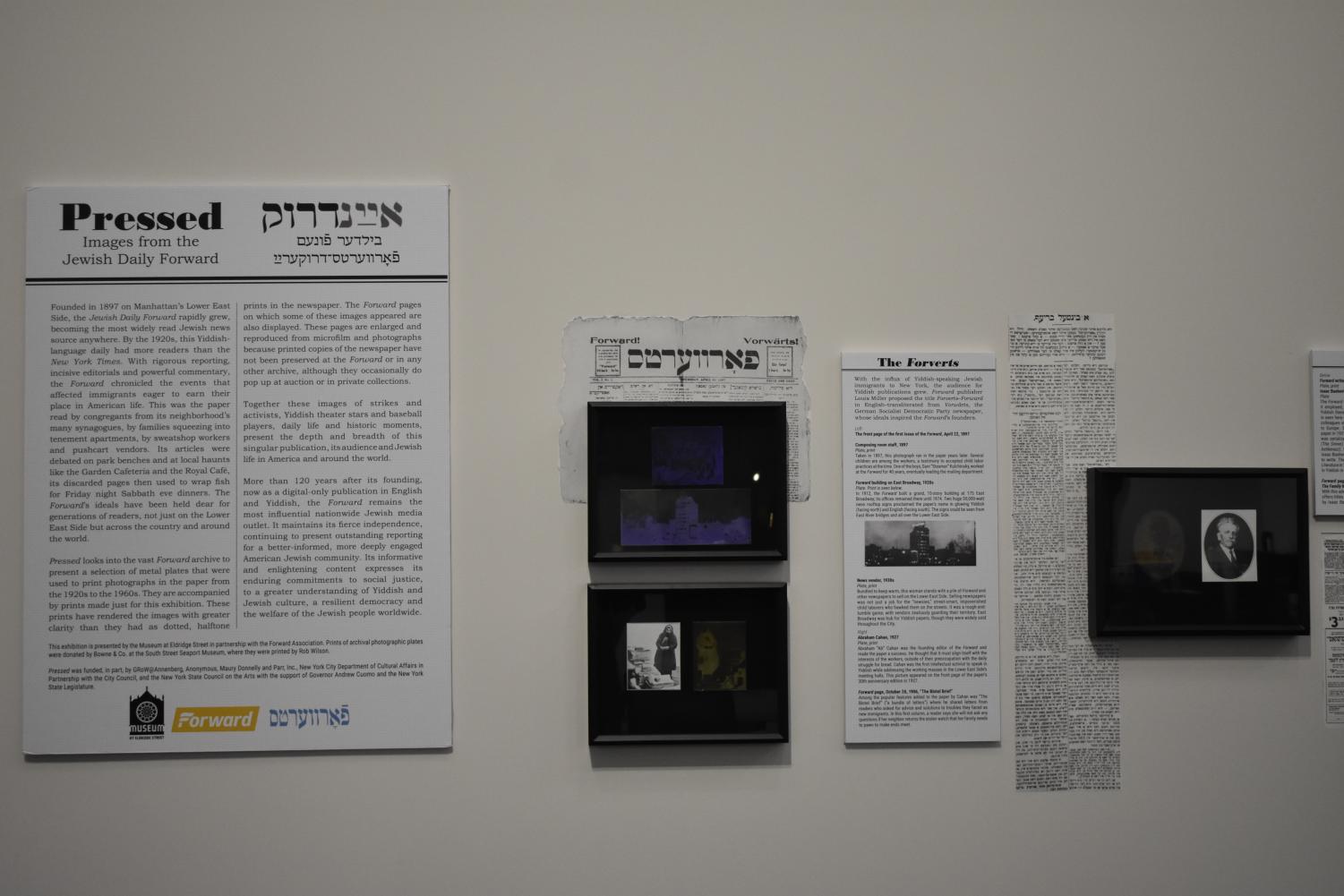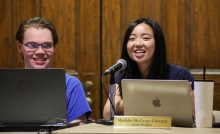‘PRESSED’ exhibit in Hillman Library connects students with Jewish journalism


The exhibit “PRESSED: Images from the Jewish Daily Forward,” on the first floor of Hillman Library.
The Jewish Daily Forward, an independent Jewish newspaper, has connected Jewish individuals for 125 years, according to Eve Wider, liaison to the Jewish studies program at Pitt Greensburg.
“My own family was in New York at the time when these prints were being done and I knew my grandparents would read the paper,” Wider said. “It’s a very exciting thing to see this [exhibit] and think about that time in the city.”
Now, artifacts from the influential newspaper are available to Pitt students through “PRESSED: Images from the Jewish Daily Forward,” an exhibit running through April in the newly renovated first floor of Hillman Library. The exhibit, organized by the Forward in collaboration with the Museum at Eldridge Street, aims to connect Jewish and non-Jewish individuals with the past, Wider said.
Last year, Wider emailed Chana Pollack, archivist of the Forward, about a current issue of the newspaper, opening a conversation about the Forward and its history. When Wider learned of Hillman Library’s new printing presses, she connected Pollack with Pitt main campus in hopes of bringing “PRESSED” to Hillman.
“I think it’s important to learn the history of our country and the different immigrant communities that came. You can see in the Forward that originally it was all in Yiddish, and then gradually as the second generation came they didn’t read Yiddish,” Wider said. “They were trying to follow the children of the people who originally came to stay relevant and connected.”
According to Pollack, the bulk of the Forward’s archival collection contains more than 40,000 community-generated gelatin-silver images. Although most newspapers would melt down their metal, photo-engraved press plates to reuse or sell them off, the Forward kept its creations. Rob Wilson, master printer at Browne & Co., the oldest printing facility in New York, made prints for the exhibit using the metal plates.
Pollack said it was important to display the prints and their original plates to the public.
“We decided it was important to identify and rehouse them. The images and the way they’re almost in negative … It was so evocative to me. It’s just very moving,” Pollack said. “Sometimes it looked very shadowy or very ghost-like. It reverberated the voices and sounds of machinery that are part of the history of the Forward.”
Through a partnership with the Museum at Eldridge Street, located in New York City, the Forward established the exhibit of press plates now housed in Hillman Library.
Nancy Johnson, curator of the Museum at Eldridge Street, said she’s always on the lookout for exhibits that resonate with the space within the museum. Through a partnership with Pollack, she learned about the breadth of topics that the Forward covered and early congregants of the Eldridge Street synagogue were reading and thinking about.
“Our idea was to look at the kind of subjects a Jewish newspaper would look at. There are photos from Africa, Israel and the neighborhood itself,” Johnson said. “Social activism was a huge deal to the Forward editors. And then there were things like sports that showed that the immigrants who read the newspaper were becoming American in their pastimes.”
The exhibit also received support from the University Library System and Pitt’s Jewish studies program, where Rachel Kranson, director of Jewish studies, is integrating the exhibit into her “Jews and the City” class to create a hands-on learning experience.
“Rachel, for her class ‘Jews and the City,’ is working to bring students to the Text & conText Lab in Hillman Library,” Wider said. “We were able to purchase the type in Hebrew, and students in the class will be able to do some printing, learning the techniques similar to those used in the Forward.”
Pollack already understood the connection between Pittsburgh and the Forward through her research into Bess Topolski, an influential journalist and the prior face of the Forward Pittsburgh office. As Pollack communicated with Kranson and learned about her research into the history of early Jewish media, they thought “PRESSED” and Pitt were the perfect match. Wider agrees.
“I think Rachel is really wonderful as a professor and is trying really hard to make things relevant and fun and tactile and connect students with history in the present,” Wider said. “It’s a really neat thing to bring the exhibit and bring this hands-on component.”
In collaboration with Heinz History Center, Pitt is also planning on an addition to “PRESSED” connecting the Forward directly to Pittsburgh, according to Wider. This addition, available in the coming weeks, will include photos of the Pittsburgh office, Pittsburgh-specific articles and even the work of students in Dr. Kranson’s “Jews and the City” course.
Pollack said she is glad to see “PRESSED” find its place at Pitt.
“I think, back in the day, the Forward was distributed and had offices in major metropolitan areas, including PIttsburgh. It’s very moving for me to see the show go to one of its homes,” Pollack said. “It’s true — we say the show travels, but it’s not so much traveling as it is visiting its home.”
Recent Posts
SGB introduces new governing code bill and addresses rumors of ICE on campus
At its weekly meeting at Nordy’s Place on Tuesday, Student Government Board introduced an omnibus…
Opinion | School should be in the summer
Although this may be controversial, I believe that from this data, it is evident that…
Weathering the storm: Pittsburgh teams have tackled some of the toughest environments
The end of the year in western Pennsylvania is always marked by two things —…
Notes From an Average Girl // Notes on Book Banning
In this edition of Notes From an Average Girl, senior staff writer Madeline Milchman writes…
To Be Honest // Yup, it is that damn phone
In this edition of To Be Honest, staff writer Evin Verbrugge writes about her phone…
Meaning at the Movies | Portraying Toxic ‘Adolescence’
In this edition of Meaning at the Movies, staff writer Lauren Deaton explores the mini-series…

